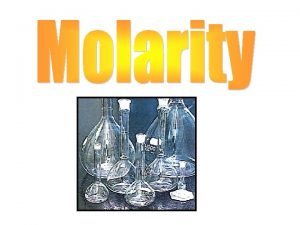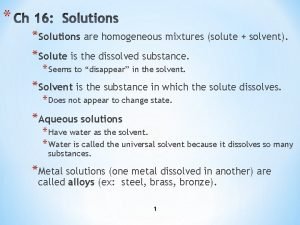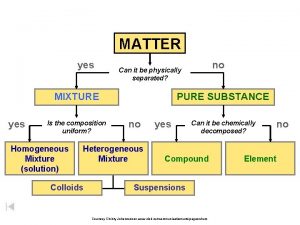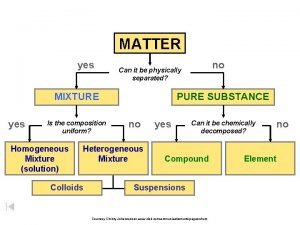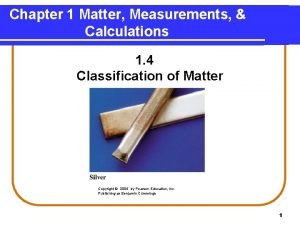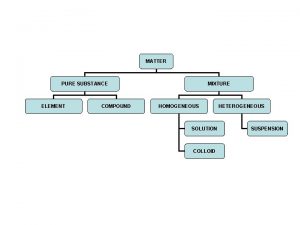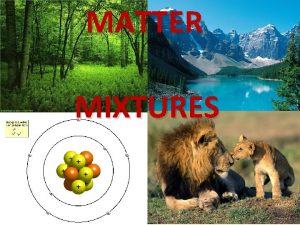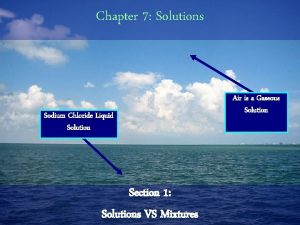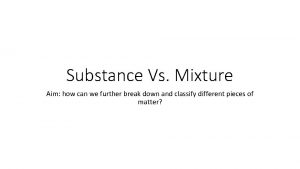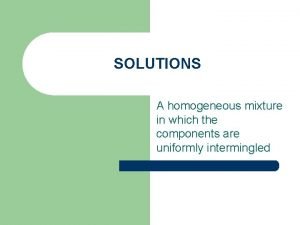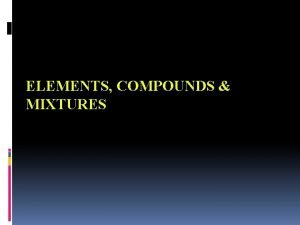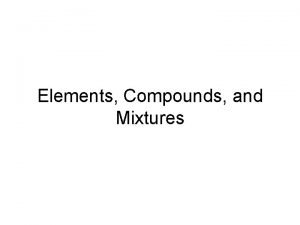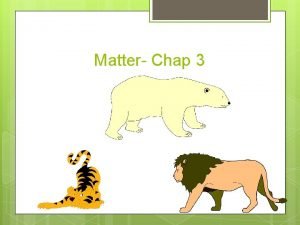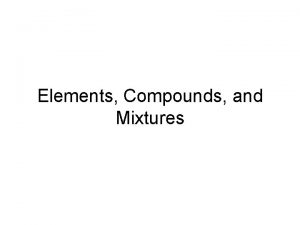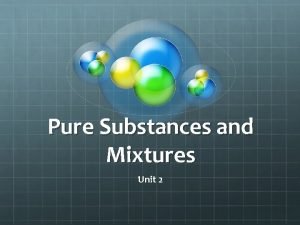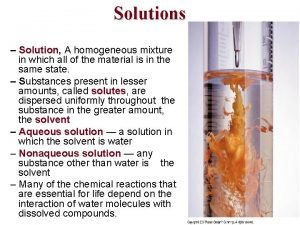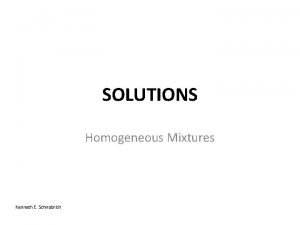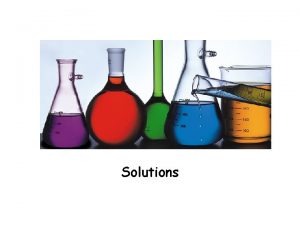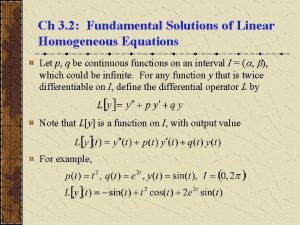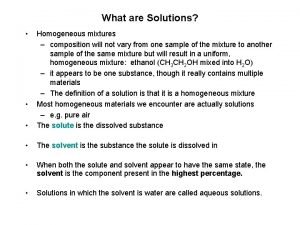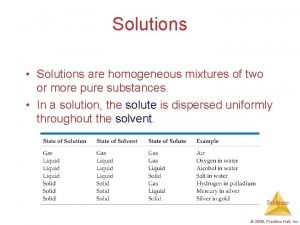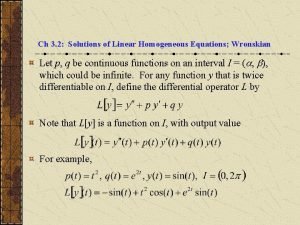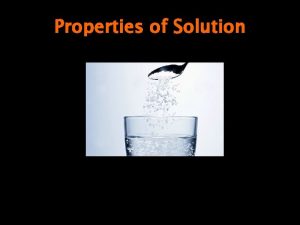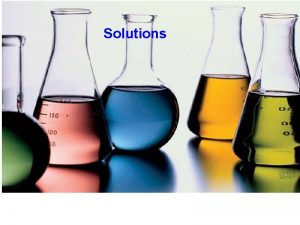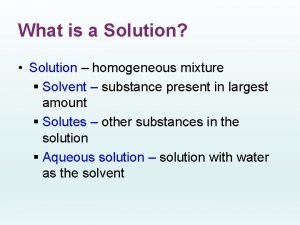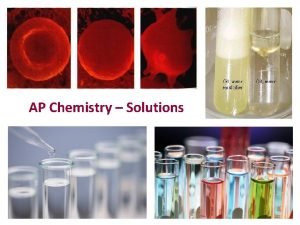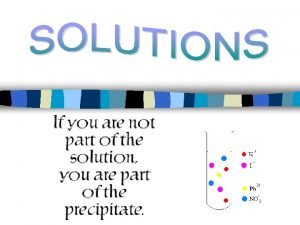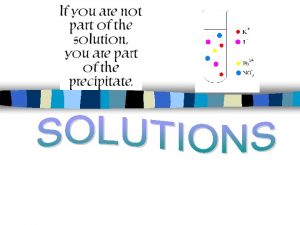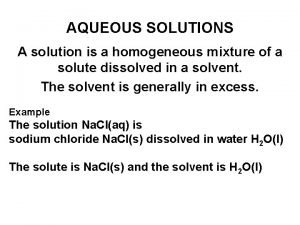I PROPERTIES OF SOLUTIONS SOLUTION a homogeneous mixture










































- Slides: 42

I. PROPERTIES OF SOLUTIONS • SOLUTION: - a homogeneous mixture - looks the same throughout • SOLUBILITY: the amount of solute (dissolved substance) that dissolves in an of solvent (substance that does the dissolving) at a specific temperature • SATURATED: a solution containing the maximum amount of dissolved solute • UNSATURATED: a solution containing less than the maximum amount of dissolved solute

• MISCIBLE: describes liquids that DO dissolve in each other Ex. Water and vinegar • IMMISCIBLE: describes liquids that DO NOT dissolve in each other Ex. Water and oil QUESTION: Why would it be wrong to say that sugar and water are miscible?

FACTORS AFFECTING SOLUBILITY: 1. Temperature: - SOLIDS are MORE soluble in liquids at HIGHER temps. - GASES are LESS soluble in liquids at HIGHER temps. Why does warm soda go “flat? ” Soda “goes flat” when the CO 2 gas escapes from the liquid; At a warm temp. the CO 2 gas is less soluble, so the gas escapes the liquid faster 2. Particle size: - SMALLER particles dissolve FASTER 3. Pressure: - GASES are MORE soluble in liquids at HIGHER pressures **4. Agitation: - Particles dissolve faster when stirred, mixed, shaken, etc.

Solubility of compounds in 100 g of H 2 O as a function of increasing temperature Solubility of Na. NO 3 At 15°C? 85 g/ 100 g H 2 O Solubility of KCl. O 3 at 70°C? 30 g/ 100 g H 2 O


Use Figure 18. 4 on pg. 504 to answer the following questions: 1. ) What is the solubility of NH 4 Cl in water at 35°C? 40 g / 100 g H 2 O 2. ) What is the solubility of Na. NO 3 in water at 10°C? 80 g / 100 g H 2 O 3. ) What is the solubility of KBr in water at 65°C? 90 g / 100 g H 2 O 4. ) What is the solubility of KNO 3 in water at 70°C? 120 g / 100 g H O 2 5. ) Which compound’s solubility is relatively unaffected by increasing temperature? How do you know? Na. Cl, b/c its solubility curve remains relatively flat 6. ) Which compound’s solubility follows a trend opposite of the others? How do you know? Yb 2(SO 4)3 ; its solubility decreases with increasing temp.

• HENRY’S LAW: Use to calculate: S 1 x P 2 = S 2 x P 1 The solubility of a gas in a liquid at different pressures S = solubility P = pressure Ex 1 : If the solubility of a gas in water is 0. 77 g/L at 3. 5 atm of pressure, what is its solubility at 1. 0 atm? S 1 = 0. 77 g/L S 1 x P 2 = S 2 x P 1 = 3. 5 atm S 2 = ? P 2 = 1. 0 atm S 1 x P 2 = S 2 P 1 0. 77 g/L x 1. 0 atm = S 2 3. 5 atm 0. 22 g/L= S 2 Note: Pressure decreased so solubility decreased

Ex 2: If the solubility of CO 2 gas in water is 1. 87 g/L at 10. 5 atm of pressure, what must the pressure be in order for the solubility to reach 2. 56 g/L? S 1 = 1. 87 g/L S 1 x P 2 = S 2 x P 1 = 10. 5 atm S 2 = 2. 56 g/L P 2 = ? P 2 = S 2 x P 1 S 1 P 2 = 2. 56 g/L x 10. 5 atm 1. 87 g/L Note: Pressure had to P 2 = 14. 37 atm increase for the solubility to increase

Page 507: 1, 2 1: S 1 = 0. 16 g/L P 1 = 104 k. Pa S 2 = ? P 2 = 288 k. Pa S 1 x P 2 = S 2 x P 1 S 1 x P 2 = S 2 P 1 (0. 16 g/L) x (288 k. Pa) = S 2 (104 k. Pa) 0. 44 g/L= S 2 Note: Pressure increased so solubility increased 2: S 1 = 3. 6 g/L S 1 x P 2 = S 2 x P 1 = 1. 0 atm S 2 = 9. 5 g/L P 2 = ? P 2 = S 2 x P 1 S 1 P 2 = (9. 5 g/L) x (1. 0 atm) (3. 6 g/L) P 2 = 2. 64 atm Note: Solubility increased b/c pressure increased

Page 508: Section Review 18. 1 (3, 4, 6) 3. temperature, particle size, and pressure 4. By using Henry’s Law : S 1 x P 2 = S 2 x P 1 6. a. Add more solvent 6. b. Add more solute

Practice: The solubility of CO 2 in a can of soda is 4. 2 g/L at 3. 2 atm of pressure. What is the solubility of the CO 2 gas when the can of soda is opened and the pressure drops to 1. 0 atm? What would happen to the solubility of the CO 2 if the temperature went up and WHY? S 1 = 4. 2 g/L P 1 = 3. 2 atm S 2 = ? P 2 = 1. 0 atm S 1 x P 2 = S 2 x P 1 S 1 x P 2 = S 2 P 1 (4. 2 g/L) x (1. 0 atm) = S 2 (3. 2 atm) 1. 3 g/L= S 2 Note: Pressure decreased so solubility decreased

II. CONCENTRATIONS OF SOLUTIONS • CONCENTRATION: a measure of the amount of solute dissolved in a given amount of solvent (a general term; no dependence on temp. ) o DILUTE SOLUTION: contains a small amount of solute o CONCENTRATED SOLUTION: contains a large amount of solute • MOLARITY (M): the unit for concentration M = mol L mol M L Used to calculate: mol = M x L mol M= L L= mol M

Ex 1: What is the molarity of a solution containing 4. 5 moles of KBr in 3. 0 L of solution? M= ? mol = 4. 5 mol L= 3. 0 L M = mol L M = 4. 5 mol 3. 0 L = 1. 5 M or 1. 5 mol/ L

Ex 2: A saline solution contains 0. 90 g of Na. Cl in exactly 100 m. L of solution. What is the molarity of the solution? M= ? (this is what we solve for) mol = ? (we get this from grams) L= ? (we get this from m. L) 0. 90 g Na. Cl x 0. 015 mol 0. 100 L 1 mol Na. Cl = ________ 58. 5 g Na. Cl 0. 015 mol Na. Cl (23. 0) + (35. 5) 100 m. L = 0. 100 L (move the decimal 3 places left) M = mol L M = 0. 015 mol 0. 100 L = 0. 15 M (or mol/L)

Ex 3: a. ) How many moles of Ca. Cl 2 is needed to make 2. 0 L of a 0. 50 M solution? b. ) How many grams is this? M= 0. 50 M (mol/ L) mol = ? (from moles, we can get the mass in grams) L= 2. 0 L mol = M x L mol M mol = (0. 50 mol/L) x (2. 0 L) mol = 1. 0 mol Ca. Cl 2 L (40. 1) + (2 x 35. 5) 1. 0 mol Ca. Cl 2 x 111. 1 g Ca. Cl 2 ________ = 1 mol Ca. Cl 2 111. 1 g Ca. Cl 2

Page 511: #9: M= ? mol = 0. 70 mol L= 0. 250 L (250 m. L = 0. 250 L) M = mol L #10: M = (0. 70 mol) (0. 250 L) M = 2. 8 mol/L M= 0. 425 mol/L mol = ? L= 0. 335 L (335 m. L = 0. 335 L) mol = M x L mol = (0. 425 mol/L) x (0. 335 L) mol = 0. 14 mol NH 4 NO 3

#11: M= 2. 0 mol/L mol = ? L= 0. 250 L (250 m. L = 0. 250 L) mol = M x L mol = (2. 0 mol/L) x (0. 250 L) mol = 0. 50 mol Ca. Cl 2 x 111. 1 g Ca. Cl 2 ________ = 1 mol Ca. Cl 2 55. 6 g Ca. Cl 2

Page 515: #21 a: M= ? (this is what we solve for) mol = ? (we get this from 400 grams) 2. 5 mol L= 4. 00 L 400 g Cu. SO 4 x M = mol L 1 mol Cu. SO 4 = ________ 159. 6 g Cu. SO 4 M = (2. 5 mol) (4. 00 L) 2. 5 mol Cu. SO 4 M = 0. 625 mol/L

Page 515: #21 b: M= ? mol = 0. 06 mol L= 1. 500 L (1500 m. L = 1. 500 L) M = mol L M = (0. 06 mol) (1. 500 L) M = 0. 04 mol/L

• DILUTION FORMULA: M 1 x V 1 = M 2 x V 2 Use to calculate: The molarity or volume of a solution made from another solution *Volume can be in L or m. L. You don’t have to convert! Making Dilutions: moles of solution before dilution = moles of solution after dilution *There are no mole or gram conversions in these problems!! Ex 1: To prepare 100. L of 0. 400 M Mg. SO 4, how many L of 0. 200 M Mg. SO 4 would you need? M 1 = 0. 400 M V 1 = 100. L M 2 = 0. 200 M V 2 = ? M 1 x V 1 = M 2 x V 2 (0. 400 M) x (100. L) = V 2 M 1 x V 1 = V 2 M 2 (0. 200 M) 200 L= V 2

Ex 2: 500 m. L of 2. 5 M Na. Cl solution is diluted to 750 m. L. What is the new molarity of the solution? M 1 = 2. 5 M V 1 = 500 m. L M 2 = ? V 2 = 750 m. L M 1 x V 1 = M 2 x V 2 (2. 5 M) x (500 m. L) = M 2 M 1 x V 1 = M 2 V 2 (750 m. L) 1. 7 M = M 2

Pg. 513: 12: M 1 = 0. 760 M V 1 = 250. 0 m. L M 2 = 4. 00 M V 2 = ? M 1 x V 1 = M 2 x V 2 (0. 760 M) x (250. 0 m. L) = V 2 M 1 x V 1 = V 2 M 2 (4. 0 M) 47. 5 m. L = V 2 13: M 1 = 0. 20 M V 1 = 250 m. L M 2 = 1. 0 M V 2 = ? M 1 x V 1 = M 2 x V 2 (0. 20 M) x (250 m. L) = V 2 M 1 x V 1 = V 2 M 2 (1. 0 M) 50 m. L = V 2

Pg. 514: ? = 10 m. L 200 m. L % v/v = ? Vol. solute (acetone) = 10 m. L Vol. solution = 200. 0 m. L 5% x 100

• Percent by volume (%(v/v)): % v/v = Volume solute x 100 Volume solution Use to calculate: %v/v or vol. of solute Ex 1: What is the percent by volume of a solution of rubbing alcohol that contains 25. 0 m. L of alcohol in 85. 0 m. L of solution? % v/v = ? 25. 0 m. L alcohol 85. 0 m. L Vol. solute (alcohol) = 25. 0 m. L Vol. solution = 85. 0 m. L % v/v = 25. 0 m. L x 100 85. 0 m. L = 29. 4%

Ex 2: A bottle of hydrogen peroxide (H 2 O 2) antiseptic is labeled 3. 0% H 2 O 2 by volume. How many m. L of H 2 O 2 are in a 400 m. L bottle of this solution? % v/v = 3. 0 % Vol. solute (H 2 O 2) = ? Vol. solution = 400 m. L 12 m. L H 2 O 2 400 m. L 388 m. L H 2 O 3. 0 % = ? 400 m. L x 100 (400 m. L ) x (3. 0 %) = ? 100 12 m. L = vol. H 2 O 2

IV. CALCULATIONS INVOLVING COLLIGATIVE PROPERTIES Because volume depends on temperature and molarity depends on Volume, we need a way of expressing solution concentration when Temperature changes. To do that, we use molality: • MOLALITY (m): m = mol solute kg solvent Although we could use this formula to solve for m, mol, or kg, we will focus on using it only to find molality (m)

Ex : Calculate the molality of a solution prepared by dissolving 7. 5 mol Li. Cl in 2. 1 kg of H 2 O. Solute = Li. Cl Solvent = H 2 O m = ? (this is what we solve for) mol = 7. 5 mol kg = 2. 1 kg m = mol kg m = 7. 5 mol 2. 1 kg = 3. 6 mol/kg

Ex : What is the molality of a solution containing 10. 0 g Na. Cl dissolved in 600. g of H 2 O? Solute = Na. Cl Solvent = H 2 O m = ? (this is what we solve for) mol = ? (we get this from g Na. Cl) 0. 17 mol kg = ? (we get this from g H 2 O) 10. 0 g Na. Cl x 0. 600 kg 1 mol Na. Cl = ________ 58. 5 g Na. Cl 0. 17 mol Na. Cl 600. g = 0. 600 kg (move the decimal 3 places left) m = mol kg m = 0. 17 mol 0. 600 kg = 0. 28 mol/kg

III. COLLIGATIVE PROPERTIES OF SOLUTIONS • COLLIGATIVE PROPERTIES: - depend only on the number of particles dissolved in a solution NOT on what they are → Remember, only IONIC compounds (metal & nonmetal) break apart in H 2 O, MOLECULAR do NOT Ex. How many particles are released when each compound dissolves in water? Na. Cl 2 Ca. F 2 3 Mg. O 2 Li. Br 2 K 2 S 3

• BOILING POINT ELEVATION: the increase in temperature between the boiling point of a solution & the boiling point of a pure solvent Ex. Salt water boils ABOVE 100°C • FREEZING POINT DEPRESSION: the decrease in temperature between the freezing point of a solution & the freezing point of a pure solvent Ex. Salt water freezes BELOW 0°C

● BOILING POINT ELEVATION: ∆Tb = Kb x m x n ∆Tb : change in Kb : Constant boiling temp. for the solvent m: molality n: # ions in solution M & _____), NM ** If the solution contains an IONIC solid ( ______ you must multiply the molality of the solution by the number of ions in solution Ex. Na. Cl (aq) → Na+ (aq) + Cl- (aq) ____ 2 ions, so n = 2 3 ions, so n = 3 Mg. Cl 2 (aq) → Mg 2+ (aq) + 2 Cl-(aq) ____

Ex 1: What is the boiling point of an aqueous 1. 50 m Na. Cl solution? Kb for H 2 O = 0. 512°C/m. ∆Tb = Kb x m x n ∆Tb = ? Kb = 0. 512 °C/m m = 1. 50 m n = 2 (Na+ and Cl-) ∆Tb = (0. 512 °C/m) x (1. 50 m) x (2) ∆Tb = 1. 5°C New boiling pt = Original b. p. of solvent + ΔTb New boiling pt = 100°C + 1. 5°C = 101. 5°C

Ex 2: What is the boiling point of a solution that contains 1. 25 mol Ca. Cl 2 in 1. 4 kg of H 2 O? Kb for H 2 O = 0. 512°C/m ∆Tb = Kb x m x n ∆Tb = ? Kb = 0. 512 °C/m 1. 25 mol Ca. Cl 2 = 0. 89 m m = 1. 4 kg H 2 O n = 3 (Ca 2+ and 2 Cl-) ∆Tb = (0. 512 °C/m) x (0. 89 m) x (3) ∆Tb = 1. 4°C New boiling pt = Original b. p. of solvent + ΔTb New boiling pt = 100°C + 1. 4°C = 101. 4°C

● FREEZING POINT DEPRESSION: ∆Tf = Kf x m x n ∆Tf : change in Kf : Constant m: molality freezing temp. for the solvent n: # ions in solution ** These problems are solved the same way as boiling point elevation problems except Kf is used and the ∆T tells you how much the temperature goes down

Ex 1: What is the freezing point of a 0. 20 m aqueous K 2 SO 4 solution? Kf for H 2 O = 1. 86°C/m. ∆Tf = Kf x m x n ∆Tf = ? Kf = 1. 86 °C/m 0. 20 m m = n = 3 (2 K+ and 1 SO 42 -) ∆Tf = (1. 86 °C/m) x (0. 20 m) x (3) ∆Tf = 1. 1°C New freezing pt = Original f. p. of solvent - ΔTf New freezing pt = 0. 0°C - 1. 1°C = - 1. 1°C

Ex 2: An aqueous solution of glucose (C 6 H 12 O 6) in water has a concentration of 0. 45 m. What is the freezing point of the solution? Kf for H 2 O = 1. 86°C/m. ∆Tf = Kf x m x n ∆Tf = ? Kf = 1. 86 °C/m m = 0. 45 m n = 1 (glucose is NOT ionic!) ∆Tf = (1. 86 °C/m) x (0. 45 m) x (1) ∆Tf = 0. 8°C New freezing pt = Original f. p. of solvent - ΔTf New freezing pt = 0. 0°C - 0. 8°C = - 0. 8°C

Ex 1: What is the freezing point of a solution in which 12. 0 mol CCl 4 is dissolved in 75. 0 kg C 6 H 6? Kf (°C/m) for C 6 H 6 is 5. 12 and the freezing point is 5. 5˚C. ∆Tf = Kf x m x n ∆Tf = ? Kf = 5. 12 °C/m = 0. 16 m m 12. 0 mol CCl 4 = 75. 0 kg C 6 H 6 n = 1 (CCl 4 is not ionic so it doesn’t break apart in water) ∆Tf = (5. 12 °C/m) x (0. 16 m) x (1) ∆Tb = 0. 8°C New freezing pt = Original f. p. of solvent - ΔT New freezing pt = 5. 5°C - 0. 8°C = 4. 7°C

Pg. 528: 55. a. What is the boiling point of a solution that contains: 0. 50 mol glucose (molecular) molecular in 1000 g of H 2 O? (Kb (°C/m) for H 2 O is 0. 512. ) ∆T = K x m x n b b ∆Tb = ? Kb = 0. 512 °C/m 0. 50 mol glucose = 0. 50 m m = 1. 000 g H 2 O n = 1 (b/c glucose is not ionic, its doesn’t break apart) ∆Tb = (0. 512 °C/m) x (0. 50 m) x (1) ∆Tb = 0. 3°C New boiling pt = Original b. p. of solvent + ΔT New boiling pt = 100°C + 0. 3°C = 100. 3°C

Pg. 528: 55. a. What is the boiling point of a solution that contains: 1. 50 mol Na. Cl in 1000 g of H 2 O? (Kb (°C/m) for H 2 O is 0. 512. ) ∆T = K x m x n b b ∆Tb = ? Kb = 0. 512 °C/m 1. 50 mol Na. Cl m = 1. 000 g H 2 O n = 1. 50 m = 2 (Na+ and Cl-) ∆Tb = (0. 512 °C/m) x (1. 50 m) x (2) ∆Tb = 1. 5°C New boiling pt = Original b. p. of solvent + ΔT New boiling pt = 100°C + 1. 5°C = 101. 5°C

Ex : Calculate the molality of a solution prepared by dissolving 24. 5 g Na. Cl in 2. 5 kg of H 2 O. Solute = Na. Cl Solvent = H 2 O m = ? (this is what we solve for) mol = ? (we get this from grams Na. Cl) 0. 42 mol kg = 2. 5 kg 24. 5 g Na. Cl x m = mol kg 1 mol Na. Cl = ________ 58. 5 g Na. Cl m = 0. 42 mol 2. 5 kg 0. 42 mol Na. Cl = 0. 17 mol/kg

Ex : How many moles of KBr must be dissolved in 2. 0 kg of water to form a 3. 1 m solution? Solute = KBr Solvent = H 2 O m = 3. 1 mol/ kg mol = ? kg = 2. 0 kg mol = 3. 1 mol x 2. 0 kg kg mol m mol = m x kg kg = 6. 2 mol

Ex : How many grams of Li. F must be dissolved in 4. 5 kg of water to form a 2. 8 m solution? Solute = Li. F Solvent = H 2 O m = 2. 8 mol/ kg mol = ? (from moles, we can find grams) kg = 4. 5 kg mol = 2. 8 mol x 4. 5 kg = 12. 6 mol kg mol m mol = m x kg kg 25. 9 g Li. F =326. 3 g Li. F 12. 6 mol Li. F x _______ 1 mol Li. F
 Homogeneous mixture and heterogeneous mixture class 9
Homogeneous mixture and heterogeneous mixture class 9 What is a solution homogeneous mixture
What is a solution homogeneous mixture Is a solution a homogeneous mixture
Is a solution a homogeneous mixture Solution homogeneous mixture
Solution homogeneous mixture Non homogeneous differential equation
Non homogeneous differential equation Homogeneous mixture of a solute in a solvent
Homogeneous mixture of a solute in a solvent Decanting
Decanting Does copper have uniform composition
Does copper have uniform composition Composition of matter flow chart
Composition of matter flow chart State of matter
State of matter Grade 7 science unit 3: mixtures and solutions answers
Grade 7 science unit 3: mixtures and solutions answers Chapter 4 basic food chemistry the nature of matter
Chapter 4 basic food chemistry the nature of matter Is blood heterogeneous mixture
Is blood heterogeneous mixture What is the mixture of vinegar
What is the mixture of vinegar Element molecule compound mixture worksheet
Element molecule compound mixture worksheet Homogeneous mixture
Homogeneous mixture What is a heterogeneous mixture
What is a heterogeneous mixture Is concrete a pure substance
Is concrete a pure substance Mixture of elements
Mixture of elements Flowchart of matter
Flowchart of matter Homogeneous mixture
Homogeneous mixture Is orange juice homogeneous or heterogeneous
Is orange juice homogeneous or heterogeneous Mixture particle diagram
Mixture particle diagram Is wine a homogeneous mixture
Is wine a homogeneous mixture Homogeneous mixture
Homogeneous mixture Is salad a mixture or solution
Is salad a mixture or solution Elements compounds and mixtures graphic organizer
Elements compounds and mixtures graphic organizer Is rice a heterogeneous mixture
Is rice a heterogeneous mixture Homogeneous mixture
Homogeneous mixture What is matter
What is matter Homogeneous mixture
Homogeneous mixture Maple syrup homogeneous or heterogeneous
Maple syrup homogeneous or heterogeneous Is mouthwash a heterogeneous mixture
Is mouthwash a heterogeneous mixture Classification of matter flow chart
Classification of matter flow chart Specific heat of neon gas
Specific heat of neon gas Definition of molarity
Definition of molarity Are solutions homogeneous
Are solutions homogeneous Are all solutions homogeneous mixtures
Are all solutions homogeneous mixtures Fundamental solutions of linear homogeneous equations
Fundamental solutions of linear homogeneous equations Are solutions homogeneous
Are solutions homogeneous Are solutions homogeneous
Are solutions homogeneous Fundamental solutions of linear homogeneous equations
Fundamental solutions of linear homogeneous equations Are all aqueous solutions homogeneous
Are all aqueous solutions homogeneous

